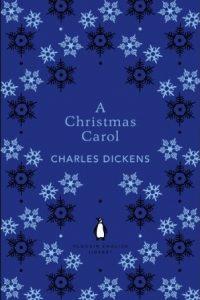“Marley was dead, to begin with. There is no doubt whatever about that. The register of his burial was signed by the clergyman, the clerk, the undertaker, and the chief mourner. Scrooge signed it.”
A ghostly and heart warming tale of finding the true meaning of Christmas.
A Christmas Carol was Charles Dickens’ first novella but his seventh major work overall. Published in 1843, it was predicted a failure. As a result, Dickens partly funded the publishing himself. Its first 6000 copies were sold out within five days and it has sold over two million copies since.
The novel was praised unanimously throughout England and has stayed in print ever since. It’s a light-hearted tale, celebrating not only Christmas but of human kindness, charity, and hope.
Summary
The book is divided into five chapters in order to depict five different events. Ebenezer Scrooge, a cheapskate bitter old man, remembers the death of his business partner, Marley. He aggressively forbids all talk of Christmas in his office, refusing to attend dinner with his nephew and even turning away poverty-stricken men at his doorstep. That night, Marley’s ghost visits him. The ghost reveals himself condemned to wander the Earth in heavy chains as penance for his lifetime of greed. The only chance Scrooge has to avoid this fate himself is to listen to three spirits. The Ghost of Christmas Past, the Ghost of Christmas Present, and the Ghost of Christmas Yet to Come all show Scrooge was his selfishness will do to both him and others around him. But will Scrooge listen?
Commentary
A Christmas Carol popularised the phrase ‘Merry Christmas’, such was its influence, and even today its legacy lives on.
Praise
- As Scrooge goes on his journey, the reader is brought along too. We look back on our own regrets and celebrations and what they might mean for the future. This book teaches you a lesson. Even though you may not be able to predict the future, you should always be kind in the present.
- It’s short, efficient, and focused. Which, for most of Dickens novels, cannot be said. This is an incredibly simple and easy to read story. Despite its heavy message, it’s perfect for finishing in an hour or two by the fireside.
- This book has been credited with ‘inventing Christmas’. Not in the literal sense, of course, but in the meaning. Dickens turned this holiday into not only a day of celebration but of contemplation. As a result, A Christmas Carol changed Christmas from a time of indulgence to a time of helping those less fortunate.
Critique
- Despite their lessons, the three ghosts are just that little bit terrifying. The Ghost of Christmas Past and Present are different, to say the least, but the real fright is the final spirit. This book is not remotely suitable for reading alone or late at night and should be kept away from young children at all costs.
- Dickens takes the term ‘descriptive’ to a whole new level. This novel is full of unnecessary words and lengthy rambling, neither of which are necessary.
- Asides from Scrooge himself, the characters are dull. None are rememberable and even less have any sort of personality. Solely created to show Scrooge the error of his ways; they lack any sense of depth themselves.
Recommendations
Overall, I’d give Charles Dickens’ A Christmas Carol a three out of five. It’s a story that makes you think, but can be a bit heavy at times.
I’d recommend this novel to teenagers and up; especially if it’s nearing Christmas. It’s the ideal novel to sit in front of the fire with for a snowy afternoon despite its heavy prose.

Want to read it for yourself?
Prefer to listen instead?
